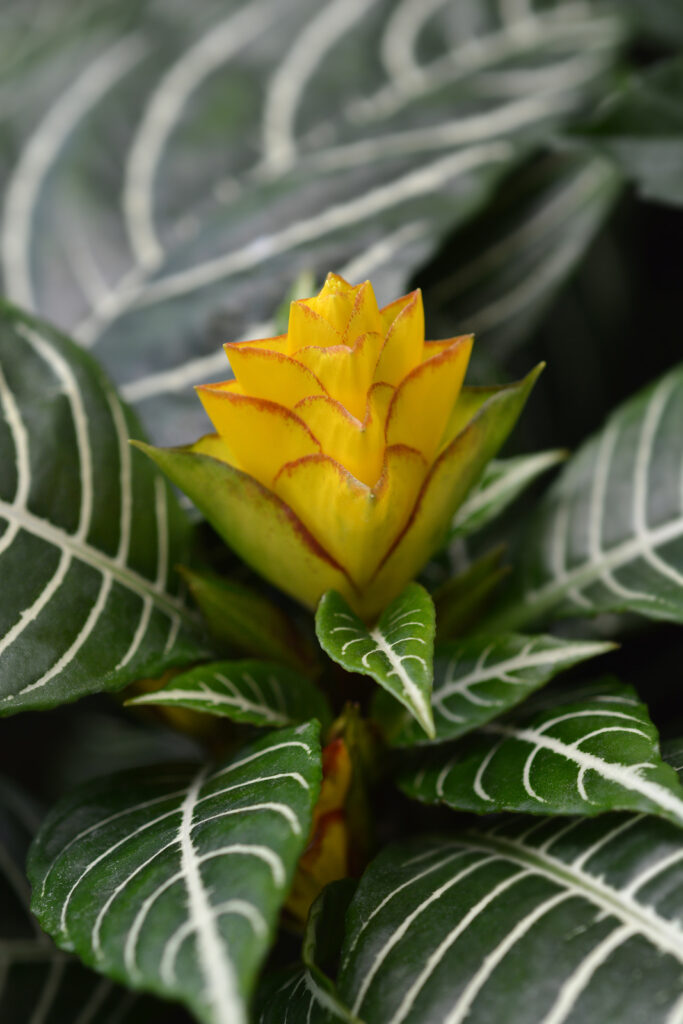Aphelandra–commonly called Zebra plant–is a dramatic plant with bright, almost silvery, striped foliage against dark green leaves. Yellow flowers come in late summer and fall.
Aphelandra are evergreen shrubs of tropical America. They are prized for their handsome leaves which in some kinds are variegated. All have showy terminal flower spikes in shades of orange or scarlet, often supplemented by large colored bracts more lasting than the flowers.
Aphelandra’s usual flowering time is fall and winter.
Old plants may be cut back when rested and grown on again, or young plants may be grown annually from cuttings.
Aphelandra is a genus of about 170 species of evergreen shrubs and subshrubs native to moist woodland in tropical regions of North, Central, and South America.
Get to know Aphelandra
- Plant type: Tropical evergreen shrub, houseplant
- Growing Zones and range: Zones 14 and 15
- Hardiness: Not frost tolerant; grow indoors in temperate regions
- Height and width: 3 to 4 feet (1-1.2m) tall and 2 to 4 feet (0.6-1.2m) wide
- Form: Shrubby plant
- Foliage: 8 to 12 inches (20-30cm) oval, glossy leaves with silvery veins on dark stems
- Flowers: Cone-shaped 4 to 6 inch showy golden yellow flowerlike bracts
- Bloom time: Late summer and fall
- Uses: Houseplant
- Common name: Zebra Plant, saffron spike
- Botanical name: Aphelandra squarrosa
- Family: Acanthaceae
- Origin: Moist tropical woodlands in North, Central, and South America
Where to plant Aphelandra
- Zebra plant needs bright light but not direct sun.
- Average home temperature is best; zebra plants will not tolerate cold drafts. The temperature should be at least 65°F (18°C)
- Grow zebra plant in all-purpose potting soil.
Planting and spacing Aphelandra
- Plant Aphelandra 2-5 feet (.6-1.5m) apart.
How to water and feed Aphelandra
- Keep the soil evenly moist but not soggy. Water with room-temperature soft water or rainwater.
- Allow the soil to dry somewhat during winter. Provide high humidity.
- Fertilize zebra plants twice a month spring through fall.

Aphelandra care
- Good humidity is important. Place the container on a tray of pebble and water or double-pot with peat moss kept wet.
- Leaves will drop if the soil is not kept evenly moist and the plant experiences a cold draft.
- After flowering, cut the stem back to just above the lowest node.
- Pinch out the tips of new growth when it reaches 6 inches (15cm) to encourage bushiness.
Growing Aphelandra as a houseplant
- Aphelandra is easy to grow indoors in an average or warm room with average humidity and bright light.
- Keep the growing medium event moist from spring through fall; in winter allow it to dry out slightly between waterings.
- Fertilize Aphelandra every two weeks from spring through early fall.
- Cut Aphelandra back in early spring to encourage compact growth.
Aphelandra pests and diseases
- Spider mites can cause stippling of leaves; raise the humidity and spray with insecticidal soap or oil.
- Mealybugs can be knocked off with a strong spray of water.
Aphelandra propagation
- Start new plants from stem cutting in late winter or early summer.
- After flowering, cut Aphelandra back the main stems to a strong pair of leaves to encourage sideshoots. When cuttings are 3-4 inches (8-10cm) long, detach them and root at 70°F (21°C).
- Propagate Aphelandra regularly, since older specimens deteriorate regularly.
Aphelandra varieties to grow
- Aphelandra aurantiaca, erect shrub with slender stems and ovate to elliptic, deep green leaves, 4-6 inches (10-15cm) long, flushed or mottled with silver. In winter, bears dense, terminal spikes, to 18 inches (45cm) long, of overlapping bracts and protruding, orange-scarlet or vermilion flowers, 1.5-2 inches (4-5cm) long. To 2.5-4.5 feet (.75-1.3m) tall and 2-4 feet (.6-1.2m) wide. Mexico to Colombia.
- A. squarrosa, Saffron-spike, Zebra plant, compact shrub with thick stems and ovate to elliptic, dark green leaves, to 12 inches (30cm) long, with white, silver, or yellow veins and midribs. Bears terminal spikes, to 8 inches (20cm) long, of waxy yellow flowers, 1-1.25 inches (2.5-3cm) long, and maroon-tinged bracts. To 5-6 feet (1.5-2m) tall and 5 feet (1.5m) wide. Tropical and subtropical America.
- A. tetragona, spreading shrub with slender stems bearing broadly ovate, dark green leaves, 9 inches (23cm) long. Produces axillary and terminal spikes, 2-3 inches (5-8cm) long, of small orange bracts and hooded, bright red flowers, 1.5-3 inches (4-8cm) long, with curved tubes. To 4 feet (1.2m) tall and wide. West Indies, Costa Rica, North South America















